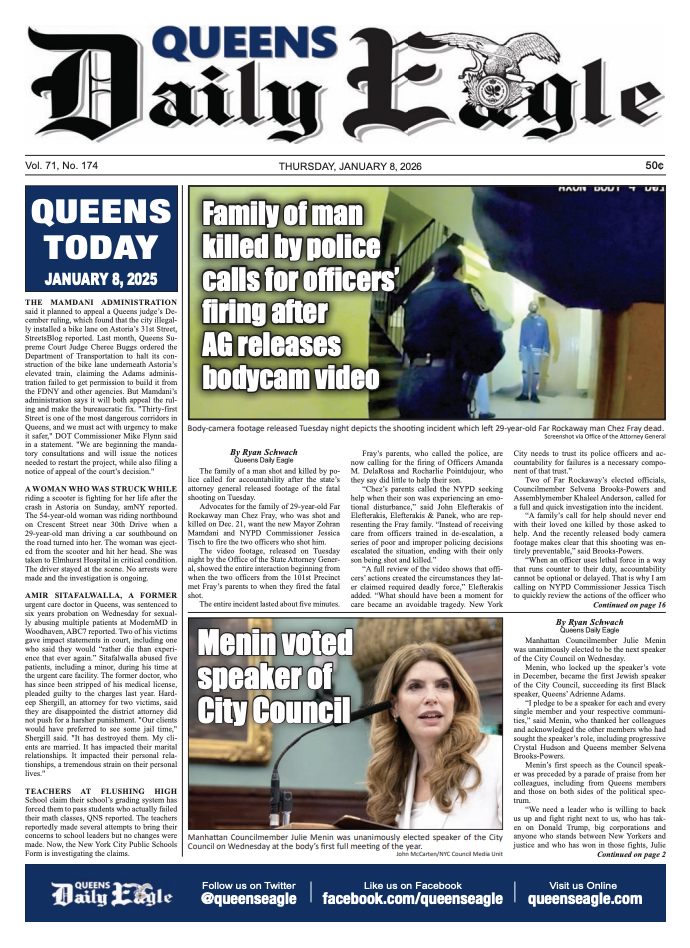Legal Analysis: Trivial Defects in Personal Injury Cases
/Hon George M. Heymann, retired Housing Court Judge and Eagle contributor. // Photo courtesy of George M. Heymann
By Hon. George M. Heymann
Eagle Legal Observer
In Simos v. Vic Armen Realty, LLC, et al, 2018 NY Slip Op 03557 (AD 2nd Dept), the plaintiff appealed the Supreme Court’s order granting defendants’ motions for summary judgment dismissal of the plaintiff’s personal injury case. The motions to dismiss asserted that the plaintiff’s injuries could not overcome, as a matter of law, the defense of a “trivial defect” and, therefore, were not actionable.
Facts
On February 8, 2008, the plaintiff allegedly broke two bones in her left ankle and ripped all her tendons and ligaments when she fell in front of defendant’s store. The plaintiff avers that her injuries were sustained as she was walking on the sidewalk and “her foot became caught in a gap between two cellar doors embedded into the sidewalk.” Plaintiff sued the owner of the building where the sidewalk and cellar doors were located, as well as the lessee of the ground floor store and basement under said doors.
The Appellate Division reversed the Supreme Court and reinstated the plaintiff’s action. The appellate court determined that the defendants failed to establish, prima facie, that the gap between the cellar doors that allegedly caused plaintiff to fall “was physically insignificant and that the characteristics of the gap or the surrounding circumstances did not increase the risks it posed to pedestrians.”
The appellate court further noted that photographic evidence and video recordings made in 2013, coupled with an expert’s affidavit after inspecting the site in 2013, five years after the date of the incident “were insufficient to establish no actionable defect existed at the time of the accident”, especially since the photos were different than those used by the parties during depositions taken in 2011.
Applicable Law
In its decision, the Appellate Division relied on two leading Court of Appeals cases that set forth the criteria in “trivial defect” defenses in slip and fall proceedings: Trincere v. County of Suffolk, (90 NY2d 976 [1997]) and Hutchinson v. Sheridan Hill House Corp (26 NY3d 66 [2015]).
Seventy years ago, in Loughran v. City of New York, 298 NY 320 (1948), the Court of Appeals held that “there is no ‘minimal dimensional test’ or per se rule that a defect must be of a certain minimal height or depth in order to be actionable.” Trincere, relying on the principals enunciated in Loughran held that the “time, place and circumstance” of an injury must be considered along with such characteristics such as the width, depth, elevation, irregularity and appearance of the defect in question.
The more recent case of Hutchinson is one of a trilogy of cases that the Court of Appeals decided on the same day (See, Heymann, Size and Defect in Slip and Fall: A Not So Trivial Pursuit, NYLJ, 2/4/16, for an analysis of the three cases). In the first of the trilogy, the Court of Appeals in Hutchinson held that the defect at issue was trivial as a matter of law because it was in a location that was well illuminated, in the middle of the sidewalk, and there were no crowds or other physical impediments that prevented the plaintiff from looking down as he walked. The object over which he tripped was a cylindrical shaped piece of metal approximately 5/8 of an inch in diameter which projected between 1/8th and ¼ of an inch above sidewalk. The Court found that the “irregular” piece of metal and “its rigidity and firm insertion into the sidewalk” are not dispositive since the same could be “true of many contours in a sidewalk. Moreover, the test established by the case law is not whether a defect is capable of catching a person’s shoe. Instead the relevant questions are whether the defect was difficult for a pedestrian to see or identify as a hazard or difficult to pass over safely on foot in light of the surrounding circumstances.” (Emphasis in original)
Conclusion
Applying these cases, the Appellate Division pointed out that while the facts of every case involving dangerous or defective conditions on the property of another must be determined on its own merits, and should be a question of fact for the jury, the burden is on the defendant to prove, prima facie, that the defect is trivial and that “under the circumstances, physically insignificant and that the characteristics of the defect or the surrounding circumstances do not increase the risk it poses. Only then does the burden shift to the plaintiff to establish an issue of fact (citing Hutchinson).”
Here, as noted above the defendants failed to meet their burden to warrant dismissal of the plaintiff’s case.
Hon. George M. Heymann is a retired New York City Housing Court Judge, of Counsel to Finz & Finz, PC and Adjunct Professor of Law at the Maurice A. Deane School of Law at Hofstra University.




